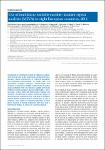Use of multilocus variable-number tandem repeat analysis (MLVA) in eight European countries, 2012
Lindstedt, Bjorn-Arne
Torpdahl, M.
Vergnaud, G.
Hello, Simon Le
Weill, F. X.
Tietze, Erhard
Malorny, Burkhard
Prendergast, D. M.
Ghallchóir, E. N.
Lista, R. F.
Schouls, L. M.
Söderlund, R.
Börjesson, S.
Åkerström, S.
Genotyping of important medical or veterinary prokaryotes has become a very important tool during the last decades. Rapid development of fragment-separation and sequencing technologies has made many new genotyping strategies possible. Among these new methods is multilocus variable-number tandem repeat analysis (MLVA). Here we present an update on the use of MLVA in eight European countries (Denmark, France, Germany, Ireland, Italy, the Netherlands, Norway and Sweden). Researchers in Europe have been active in developing and implementing a large array of different assays. MLVA has been used as a typing tool in several contexts, from aiding in resolving outbreaks of food-borne bacteria to typing organisms that may pose a bioterrorist threat, as well as in scientific studies.
Dateien zu dieser Publikation
Keine Lizenzangabe
Verwandte Publikationen
Anzeige der Publikationen mit ähnlichem Titel, Autor, Urheber und Thema.
-
2004-04-01ZeitschriftenartikelBakterielle Erreger von Krankenhausinfektionen mit besonderen Resistenzen und Multiresistenzen Teil I: Diagnostik und TypisierungWitte, Wolfgang; Strommenger, Birgit; Klare, Ingo; Werner, GuidoFür fast jede der therapeutisch gegen bakterielle Infektionserreger eingesetzten Antibiotikagruppen gibt es mehrere Einzelpräparate, die in der klinisch-bakteriologischen Routinediagnostik in der Empfindlichkeitsprüfung ...
-
2015-07-02ZeitschriftenartikelCurrent prevalence of multidrug-resistant organisms in long-term care facilities in the Rhine-Main district, Germany, 2013 Hogardt, Michael; Proba, P; Mischler, D.; Cuny, Christiane; Kempf, V. A.; Heudorf, U.Multidrug-resistant organisms (MDRO) and in particular multidrug-resistant Gram-negative organisms (MRGN) are an increasing problem in hospital care. However, data on the current prevalence of MDRO in long-term care ...
-
2006-08-16ZeitschriftenartikelHow long do nosocomial pathogens persist on inanimate surfaces? A systematic review Kramer, Axel; Schwebke, Ingeborg; Kampf, GünterBackground: Inanimate surfaces have often been described as the source for outbreaks of nosocomial infections. The aim of this review is to summarize data on the persistence of different nosocomial pathogens on inanimate ...

